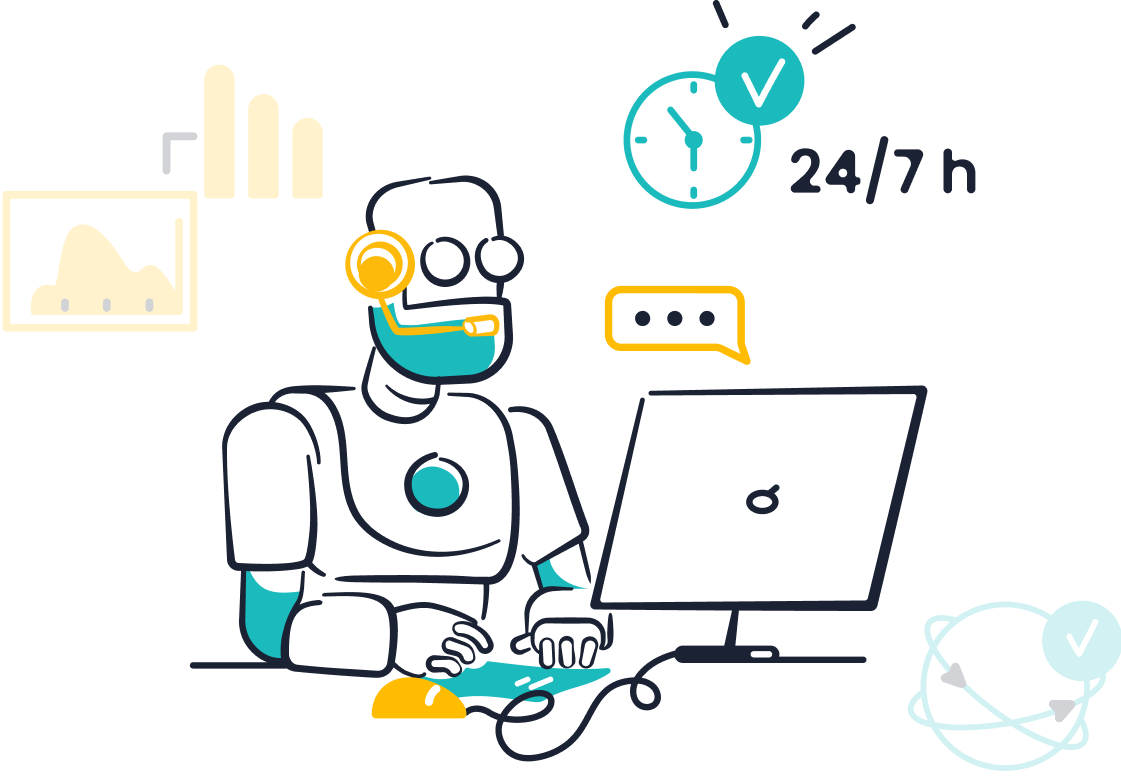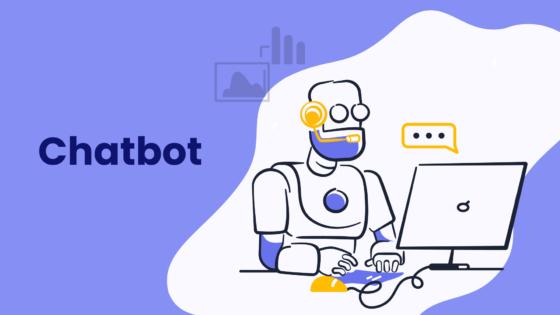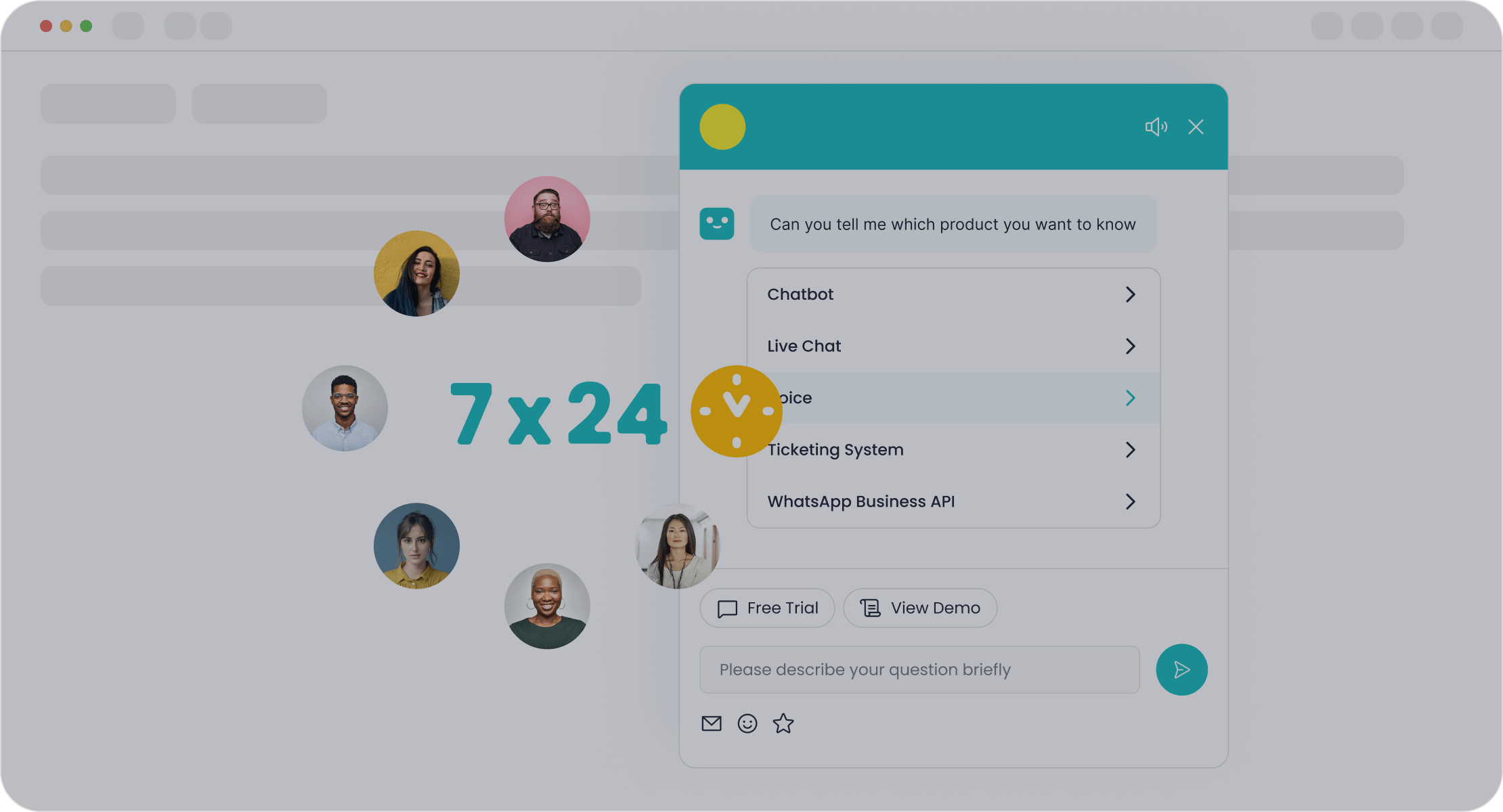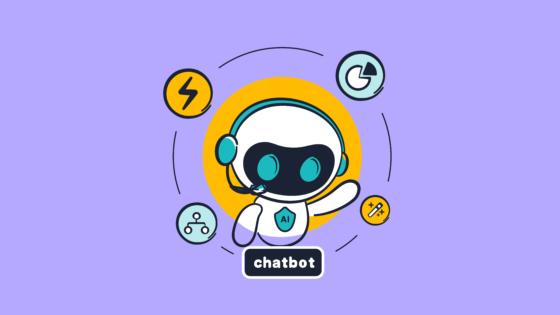AI Chatbots vs Human Agents: Efficiency vs Empathy

When you reach out for help, do you prefer a quick solution or a warm, understanding response? This question lies at the heart of the customer service debate: efficiency versus empathy. Businesses face this challenge daily, balancing the speed and cost-effectiveness of AI chatbots with the human touch that builds trust.
AI chatbots in customer service are transforming how businesses operate. They can handle thousands of queries per second, cut call volumes by half, and resolve 80% of routine questions without needing human agents. Companies like Sobot are leading the charge, offering tools that save time and improve customer satisfaction. But can efficiency alone replace the value of empathy?
AI Chatbots in Customer Service: Strengths and Limitations

Efficiency and Scalability
AI chatbots in customer service excel at handling large volumes of inquiries. Imagine having thousands of customers reaching out simultaneously—chatbots can manage this effortlessly. They provide instant responses, ensuring no one waits in line. This scalability makes them ideal for businesses experiencing seasonal spikes or rapid growth.

For example, the global AI chatbot market is projected to hit $27.2 billion by 2030, highlighting their growing importance. Chatbots reduce the burden on your helpdesk team by automating repetitive tasks. They also deliver consistent and accurate answers, which improves customer satisfaction. With tools like Sobot’s AI-powered chatbots, businesses can boost productivity by up to 70% while cutting costs.
| Strengths | Limitations |
|---|---|
| 24/7 Availability and Instant Responses | Limited Emotional Intelligence |
| Cost Efficiency and Scalability | Dependence on Predefined Data |
| Consistency and Accuracy | Integration Complexities |
| Multilingual Support | Security and Privacy Risks |
| Personalized Experiences | Customer Preference for Human Interaction |
24/7 Availability and Cost Savings
AI chatbots never sleep. They’re available around the clock, ensuring your customers always get the help they need. Whether it’s midnight or a holiday, chatbots can answer questions instantly. This 24/7 availability is a game-changer for businesses. In fact, 64% of internet users say round-the-clock service is a crucial feature.
Chatbots also save money. By eliminating the need for night or weekend shifts, businesses can cut operational costs significantly. Studies show that companies can save up to $8 billion annually by using chatbots. Sobot’s AI chatbots, for instance, operate full-time and reduce service costs by up to 50%. They’re not just efficient—they’re cost-effective too.
Challenges in Emotional Intelligence and Context Understanding
While AI chatbots are great at solving routine problems, they struggle with emotional intelligence. They can’t pick up on subtle cues like frustration or sarcasm. This limitation can lead to insensitive responses, which might upset your customers.
Context understanding is another hurdle. Chatbots rely on predefined data, so they may give incorrect answers if the information is outdated. A study found that users rated emotionally sensitive chatbots higher in trustworthiness and supportiveness compared to those lacking this trait. Emotional receptiveness matters, especially in customer service.
Despite these challenges, AI chatbots continue to evolve. Advanced solutions like Sobot’s AI-powered chatbots use generative AI to improve contextual understanding. While they may not replace human empathy, they’re getting closer to bridging the gap.
Human Agents in Customer Service: Strengths and Limitations
Empathy and Personalization
When it comes to empathy, human agents shine. They can sense frustration in your tone or pick up on subtle cues that a chatbot might miss. This emotional intelligence allows them to connect with you on a deeper level, offering reassurance and understanding during stressful situations. For instance, if you’re upset about a delayed delivery, a human agent can not only apologize but also empathize with your frustration, making you feel heard.
Human customer service also excels in personalization. Agents can adapt their responses based on your unique needs. Whether you’re asking about a product recommendation or seeking help with a complex issue, they can tailor their approach to suit you. Studies show that customers report higher satisfaction and are more likely to return after interacting with human agents compared to chatbots. This is because the perceived empathy of the agent plays a significant role in shaping your overall experience.
| Finding | Description |
|---|---|
| Satisfaction | Customers feel more satisfied after interacting with human agents. |
| Repatronage Intentions | Higher likelihood of returning due to the empathetic and personalized care. |
Problem-Solving in Complex Scenarios
Human agents are problem-solving experts. They can think critically and adjust their approach when faced with unique or complicated issues. Imagine you’re dealing with a billing error that involves multiple transactions. A chatbot might struggle to piece everything together, but a human agent can analyze the situation, ask clarifying questions, and resolve the issue efficiently.
Metrics like First Contact Resolution (FCR) highlight this strength. Human agents often resolve inquiries in a single interaction, reducing the need for follow-ups. However, their Average Handle Time (AHT) might be longer since they take the time to fully understand and address your concerns. This trade-off often results in higher customer satisfaction, as you leave the interaction feeling valued and supported.
| Metric | Description |
|---|---|
| First Contact Resolution (FCR) | Percentage of inquiries resolved in the first interaction without callbacks or transfers. |
| Average Handle Time (AHT) | Average time taken to handle a customer inquiry, including talk time and hold time. |
| Customer Satisfaction (CSAT) | Average satisfaction rating given by customers interacting with each agent. |
Resource-Intensive Nature and Limited Availability
Despite their strengths, human agents come with limitations. They require training, supervision, and ongoing support, which can be resource-intensive for businesses. Unlike chatbots, they can’t work 24/7 without breaks. This means you might have to wait longer for assistance during peak hours or outside regular business times.
Additionally, human customer service teams can only handle a limited number of inquiries at once. If you’ve ever been placed on hold during a busy period, you’ve experienced this firsthand. While businesses like OPPO have successfully combined human agents with AI chatbots to manage workloads, the reliance on human agents alone can lead to bottlenecks.
Still, the value they bring in terms of empathy and problem-solving often outweighs these challenges. By integrating tools like Sobot’s AI solutions, businesses can strike a balance, using chatbots for routine tasks and reserving human agents for more complex or emotionally charged interactions.
AI vs Human: A Comparative Analysis
Efficiency: AI Chatbots Leading the Way
When it comes to efficiency, AI chatbots are in a league of their own. They respond instantly, handle unlimited inquiries at once, and never take a break. Imagine needing help at 3 a.m.—a chatbot is always ready to assist. This 24/7 availability eliminates wait times and ensures your customers get answers when they need them.
Here’s how AI chatbots stack up against human agents:
| Performance Metric | AI Support | Human Support | Impact on Operations |
|---|---|---|---|
| Response Speed | Instant 24/7 | Variable (1-5 mins) | AI eliminates wait times |
| Concurrent Inquiries | Unlimited | One per agent | Higher throughput with AI |
| Peak Handling | Automatic scaling | Needs extra staff | Reduced operational strain |
| Consistency | Fully standardized | Varies by agent | Better quality control |
| Complex Issue Resolution | Limited to set tasks | High capability | Complementary strengths |
Over 55% of customers appreciate the instant responses AI provides. Businesses also benefit from reduced costs and improved speed. For example, companies like NIB saved $22 million by automating customer service. By 2025, AI is expected to handle 95% of all customer interactions, showcasing its dominance in efficiency.
However, efficiency isn’t just about speed. AI chatbots excel at routine tasks, freeing up human agents to focus on complex issues. This hybrid approach saves costs while maintaining customer satisfaction.
Empathy: Human Agents as the Gold Standard
While AI chatbots lead in efficiency, human agents remain unmatched in empathy. You’ve probably experienced this yourself—when you’re frustrated or upset, talking to a real person feels more comforting. Human agents can sense your emotions, adapt their tone, and offer personalized solutions that make you feel valued.
Empathy cannot be automated. Customers want to feel heard and understood, and only humans can provide that. Relationships built through positive interactions with human agents foster brand loyalty. You’re more likely to remember a company that treated you with care and respect.
Human agents also bring creativity and judgment to the table. They can think outside the box to solve unique problems. For example, if you’re dealing with a billing error involving multiple transactions, a human agent can analyze the situation and resolve it efficiently. This adaptability is something AI struggles to replicate.
| Key Strengths of Human Agents | Description |
|---|---|
| Empathy | Ability to connect emotionally and make customers feel valued |
| Personalization | Tailored responses based on individual needs |
| Creativity | Innovative problem-solving for unique scenarios |
| Judgment | Contextual understanding and nuanced decision-making |
Studies show that 52% of customers prefer human agents for their empathy and understanding. While AI chatbots are improving, they can’t replace the human touch.
Common Challenges and Overlaps
Both AI chatbots and human agents face challenges in customer service. For instance, building trust can be difficult for both. Customers may hesitate to trust chatbots due to their lack of emotional intelligence. On the other hand, human agents might struggle with consistency, as their responses can vary based on mood or experience.
Here are some overlapping challenges:
- Both AI and humans can misinterpret customer intent. Chatbots may struggle with slang or double meanings, while human agents might misread tone or context.
- Solutions requiring detailed background information can be tricky for both. If the customer doesn’t provide enough details, it impacts the quality of the response.
- Emotional intelligence remains a hurdle. While humans excel here, they can still miss subtle cues, especially in text-based interactions.
Despite these challenges, combining AI and human strengths can create a balanced approach. AI handles repetitive tasks, while humans step in for complex or emotionally charged situations. This collaboration ensures efficiency without sacrificing empathy.
The Hybrid Approach: Combining AI Chatbots and Human Agents

Leveraging AI Chatbots for Routine Queries
Imagine this: You’re running a business, and your team is swamped with repetitive questions like “What are your store hours?” or “How do I reset my password?” These routine queries can eat up valuable time. That’s where AI chatbots step in. They handle these straightforward tasks with lightning speed, freeing up your human agents to focus on more complex issues.
Chatbots excel at providing instant responses, which improves the overall customer experience. They’re like the first line of defense, ensuring no query goes unanswered. Metrics like first response time and deflection rate highlight their effectiveness. For example:
- Chatbots reduce average resolution times by quickly addressing common questions.
- They deflect up to 80% of routine inquiries, allowing your team to focus on high-value tasks.
- User satisfaction often increases because customers get answers faster.
With tools like Sobot’s AI-powered chatbots, you can automate these interactions while maintaining accuracy and consistency. This not only saves time but also enhances customer engagement by ensuring every query gets a response, no matter the time of day.
Tip: Use chatbots to handle FAQs and repetitive tasks. This ensures your human agents can focus on delivering personalized interactions where they’re needed most.
Escalating Complex Issues to Human Agents
Not every problem can be solved with automation. Sometimes, customers need a human touch—especially when dealing with complex or emotionally charged issues. Think about a situation where a customer is frustrated about a billing error or a delayed shipment. A chatbot might provide basic information, but it can’t empathize or think creatively to resolve the issue.
This is where human agents shine. They bring emotional intelligence and problem-solving skills to the table. A hybrid approach ensures that when a chatbot reaches its limits, the issue gets escalated seamlessly to a human agent. For this to work effectively, clear escalation paths are essential. Here’s how it benefits both you and your customers:
- Chatbots triage queries based on complexity and urgency, ensuring simple issues are resolved automatically.
- Complex problems are directed to human agents, who can provide personalized solutions.
- Context preservation ensures a smooth transition, so customers don’t have to repeat themselves.
For example, Sobot’s AI solutions integrate chatbots with human agents, ensuring continuity in customer interactions. This structured approach prevents customers from feeling stuck in an automated loop, improving their overall experience.
Note: Always ensure your chatbot can recognize when it’s time to escalate. This keeps customers happy and avoids unnecessary frustration.
Benefits of a Hybrid Model for Businesses and Customers
Combining AI chatbots and human agents creates a win-win situation. You get the best of both worlds: the speed and efficiency of AI with the empathy and creativity of human agents. This hybrid model doesn’t just improve operations—it transforms the customer experience.
Here’s why it works so well:
-
For Businesses:
- Chatbots reduce operational costs by minimizing the need for 24/7 staffing.
- Human agents focus on complex issues, enhancing service quality.
- The hybrid strategy combines cost leadership with differentiation, making it more profitable than relying on a single approach.
-
For Customers:
- Faster query resolution improves satisfaction.
- Personalized interactions build trust and loyalty.
- A seamless transition between AI and human agents ensures a smooth journey.
Empirical studies show that hybrid strategies outperform pure approaches. They allow businesses to adapt to market changes while meeting customer expectations for both speed and personalization. With Sobot’s solutions, you can achieve this balance effortlessly.
Takeaway: A hybrid model isn’t just about efficiency—it’s about creating meaningful customer engagement. By leveraging the strengths of both AI and human agents, you can deliver an experience that’s fast, empathetic, and tailored to your customers’ needs.
Sobot’s Role in Optimizing Customer Service
Sobot AI Chatbot: Enhancing Efficiency and Reducing Costs
Sobot’s AI Chatbot is a game-changer for businesses looking to improve customer support. It’s designed to handle routine queries, reduce costs, and boost operational efficiency. Over two years, Sobot’s self-service platform reduced inbound discussion volumes by 20%. This means fewer repetitive questions for your team and more time to focus on complex issues.
The chatbot doesn’t just save time—it also improves service quality. With an impressive 97% customer satisfaction score, it ensures over 80% of answers are accurate. Plus, 85% of problems are resolved, leading to a customer happiness rate of 99%. These numbers show how Sobot’s solutions enhance both efficiency and accuracy.
What’s more, Sobot’s intelligent tools empower 22.2% of customers to find answers on their own. This independence builds trust and satisfaction, especially among VIP customers. By automating repetitive tasks, Sobot helps you deliver high-quality customer support while cutting costs by up to 50%.
Real-World Success: OPPO’s Customer Service Transformation
OPPO’s partnership with Sobot is a perfect example of how technology can transform customer support. During peak shopping seasons, OPPO faced a surge in inquiries. Sobot’s chatbot stepped in to handle repetitive questions, allowing human agents to focus on complex issues. This collaboration improved service quality and reduced wait times.
The results speak for themselves. OPPO achieved an 83% chatbot resolution rate and a 94% positive feedback score. Even better, their repurchase rate jumped by 57%. Sobot also helped OPPO optimize its knowledge base, cutting maintenance efforts by 90%. By integrating global customer channels, OPPO streamlined operations and improved accuracy in responses.
This success story highlights how Sobot’s solutions can help businesses like yours enhance customer satisfaction and operational efficiency.
Sobot’s Vision for Balancing Efficiency and Empathy
At Sobot, the goal isn’t just about efficiency—it’s about creating meaningful customer experiences. The company believes that balancing speed with empathy is the key to exceptional customer support. That’s why Sobot combines AI-powered tools with human expertise.
The chatbot handles routine tasks with unmatched accuracy, while human agents step in for complex or emotional issues. This hybrid approach ensures customers feel valued and supported. Sobot’s vision is to empower businesses to deliver fast, reliable, and empathetic service. By focusing on both efficiency and empathy, Sobot helps you build trust and loyalty with your customers.
AI chatbots and human agents each bring unique strengths to customer service. Chatbots excel in efficiency, handling routine queries instantly and operating 24/7. Human agents, on the other hand, offer empathy and personalized solutions that build customer trust. However, both have limitations—chatbots lack emotional intelligence, while human agents are resource-intensive and less scalable.
Balancing efficiency and empathy is essential for delivering an optimal customer service experience. A hybrid approach combines the best of both worlds. Chatbots handle repetitive tasks, while human agents focus on complex or emotional issues. This strategy not only enhances customer satisfaction but also fosters loyalty by addressing diverse needs effectively.
| Statistic | Description |
|---|---|
| 53% | Customers believe AI will better cater to their needs. |
| 72% | Individuals report improved quality from AI chat interactions. |
To get started, implement AI chatbots for routine queries. Gradually integrate human agents for more nuanced interactions. Continuously optimize your system based on customer feedback to ensure a seamless customer experience. This approach will help you build customer trust and deliver exceptional service.
Pro Tip: A hybrid model isn’t just efficient—it’s the key to creating meaningful connections with your customers.
FAQ
What is the main advantage of using AI chatbots in customer service?
AI chatbots excel at handling repetitive tasks quickly and efficiently. They’re available 24/7, provide instant responses, and reduce operational costs. This makes them perfect for managing routine queries while freeing up human agents for more complex issues.
Can AI chatbots replace human agents entirely?
Not yet! While chatbots handle routine tasks well, they lack emotional intelligence and creativity. Human agents are still essential for solving complex problems and providing empathetic, personalized support. A hybrid approach combines the strengths of both for the best results.
How do I know when to escalate an issue to a human agent?
If a chatbot struggles to understand the query or the customer seems frustrated, it’s time to escalate. Tools like Sobot’s AI solutions ensure seamless transitions by preserving context, so customers don’t have to repeat themselves.
Are AI chatbots secure for handling sensitive customer data?
Yes, but only if you choose a reliable provider. Sobot’s AI chatbots, for example, comply with data protection regulations like GDPR. They use encryption and secure backups to keep customer information safe. Always verify a provider’s security measures before implementation.
How can a hybrid model improve customer satisfaction?
A hybrid model combines the speed of AI with the empathy of human agents. Chatbots handle routine queries instantly, while human agents focus on complex or emotional issues. This balance ensures faster resolutions, personalized care, and a better overall experience for your customers.
Pro Tip: Start small with chatbots for FAQs, then expand to a hybrid model as your business grows.
See Also
Enhancing Efficiency With AI-Driven Customer Service Solutions
Increasing Customer Satisfaction Through E-commerce Chatbots
Effective Strategies for Managing Live Chat Support Agents
